CADILLAC DEVILLE 1998 7.G Owners Manual
Manufacturer: CADILLAC, Model Year: 1998, Model line: DEVILLE, Model: CADILLAC DEVILLE 1998 7.GPages: 386, PDF Size: 22.36 MB
Page 321 of 386

Downloaded from www.Manualslib.com manuals search engine I
5. Reinstall the headlamp housing socket back into the
headlamp assembly.
Front nrn Signal Lamps
1. The turn signal lamps are located below the
headlamps. To access, lift
off the headlamp cover
(see Step
1 under “Headlamps”).
2. Turn the housing socket to the right to unlock the
socket from the lamp housing.
6-34
Page 322 of 386

Downloaded from www.Manualslib.com manuals search engine r-
Center High-Mounted Stoplamp (CHMSL)
3. Remove the turn signal lamp housing socket and
replace the bulb.
1. Lift the trim cover to remove.
2. Twist the socket to the left and remove the socket
and bulb from the housing.
6-35
Page 323 of 386

Downloaded from www.Manualslib.com manuals search engine i
Rear Thm
A
3. ‘Replace the bulb.
Reverse the steps to reassemble the stoplamp assembly.
1. Loosen the upper Tom@ screw, but don’t remove it.
2. Gently tilt the top portion of the lamp housing to
access the bulb sockets.
If you can’t access the lower
bulb socket, remove the lamp housing completely.
6-36 t.
Page 324 of 386

Downloaded from www.Manualslib.com manuals search engine 3. Press the bulb socket housing lever ind rotate the
socket to the left to remove it. 4. Replace the bulb by pressing and turning it to
the left.
5. Once you have installed the new bulb and socket into
the lamp housing, insert the tab on the lower portion
of the lamp housing first, then gently fit the rest of
the housing in place.
6-37
Page 325 of 386
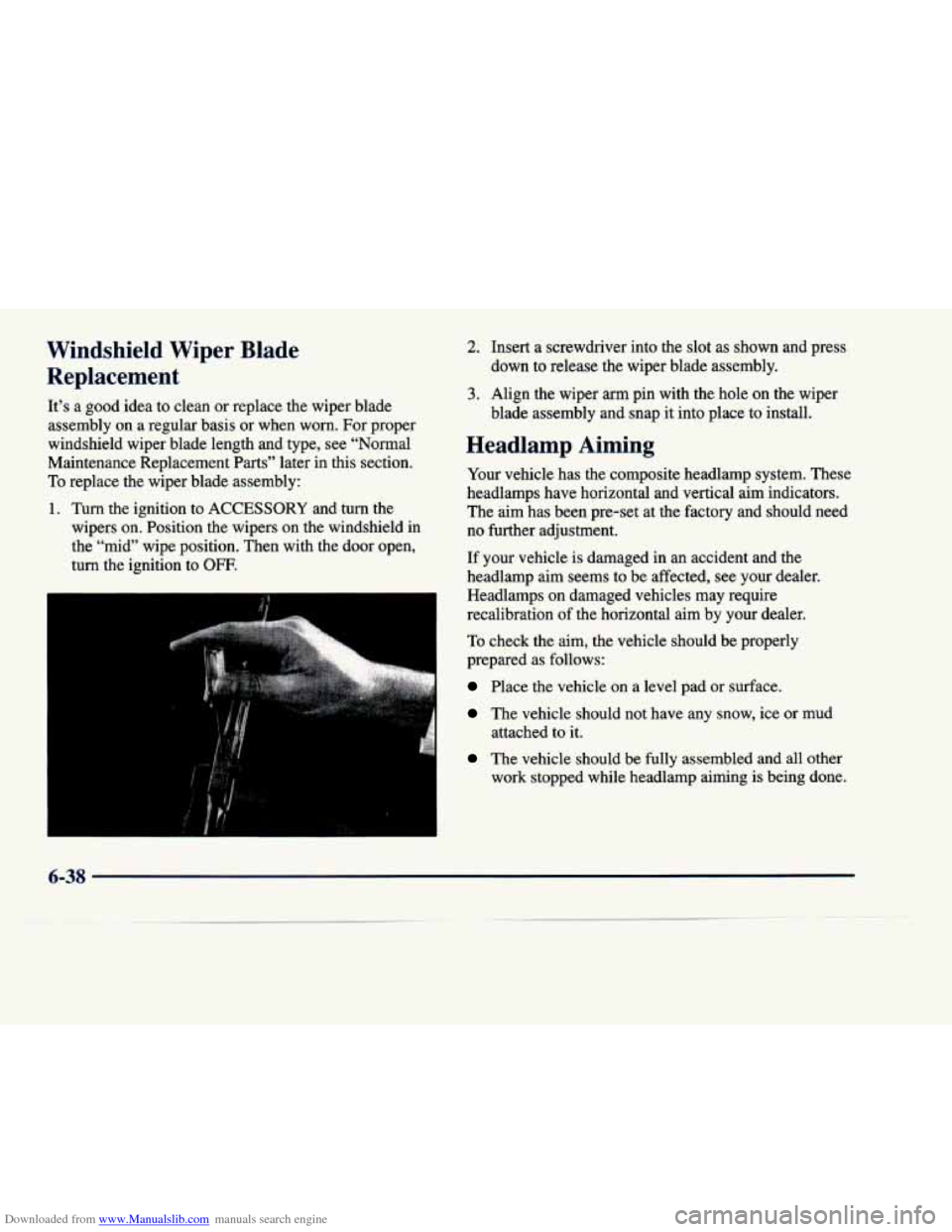
Downloaded from www.Manualslib.com manuals search engine Windshield Wiper Blade
Replacement
It’s a good iaea to clean or replace the wiper blade
assembly on a regular basis or when worn. For proper
windshield wiper blade length and type, see “Normal
Maintenance Replacement Parts” later in this section.
To replace the wiper blade assembly:
1. Turn the ignition to ACCESSORY and turn the
wipers on. Position the wipers on the windshield in
the
“mid” wipe position. Then with the door open,
turn the ignition to
OFF.
2. Insert a screwdriver into the slot as shown and press
down to release the wiper blade assembly.
3. Align the wiper arm pin with the hole on the wiper
blade assembly and snap it into place to install.
Headlamp Aiming
Your vehicle has the composite headlamp system. These
headlamps have horizontal and vertical aim indicators.
The
aim has been pre-set at the factory and should need
no further adjustment.
If your vehicle is damaged in an accident and the
headlamp aim seems to be affected, see your dealer.
Headlamps on damaged vehicles may require
recalibration of the horizontal aim by your dealer.
To check the aim, the vehicle should be properly
prepared as follows:
Place the vehicle on a level pad or surface.
The vehicle should not have any snow, ice or mud
The vehicle should be fully assembled and all other
work stopped while headlamp aiming is being done.
attached to it.
6-38
Page 326 of 386
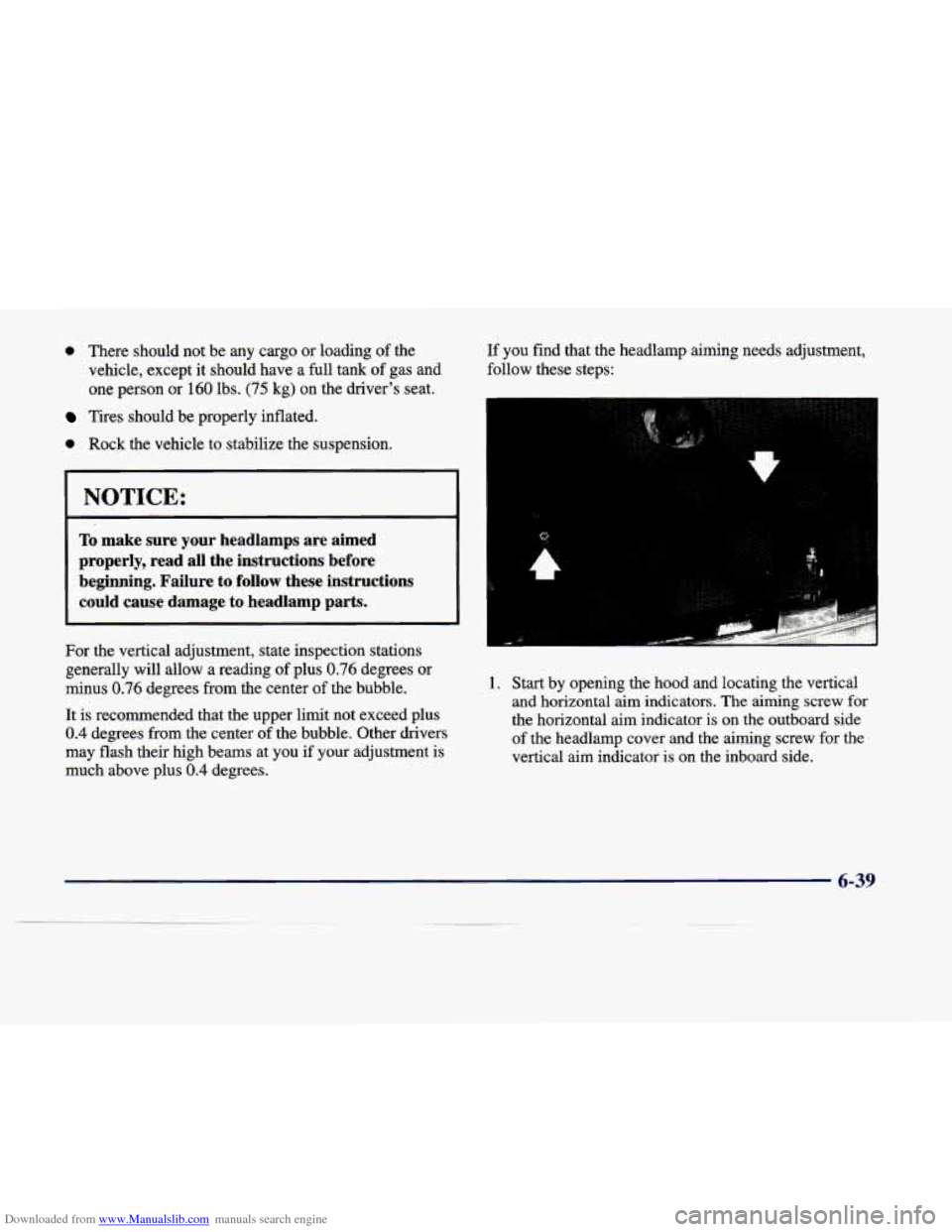
Downloaded from www.Manualslib.com manuals search engine 0 There should not be any cargo or loading of the
vehicle, except it should have a full tank of gas and
one person or 160 lbs. (75 kg) on the driver’s seat.
Tires should be properly inflated.
0 Rock the vehicle to stabilize the suspension.
NOTICE:
L
To make sure your headlamps are aimed
properly, read all the instructions before
beginning. Failure to follow these instructions could cause damage to headlamp parts.
For the vertical adjustment, state inspection stations
generally will allow a reading of plus 0.76 degrees or
minus 0.76 degrees from the center of the bubble.
It is recommended that the upper limit not exceed plus
0.4 degrees from the center of the bubble. Other drivers
may flash their high beams at you if your adjustment
is
much above plus 0.4 degrees. If you
find that the headlamp aiming needs adjustment,
follow these steps:
..
. ,..
1. Start by opening the hood and locating the vertical
and horizontal aim indicators. The aiming screw for
the horizontal aim indicator is on the outboard side
of the headlamp cover and the aiming screw for the
vertical aim indicator is on the inboard side.
6-39
Page 327 of 386

Downloaded from www.Manualslib.com manuals search engine 2. Check the vertical headlamp aim first. Keep in mind
that your vehicle needs to be on a level surface. Turn
the vertical aiming screw until the bubble inside the
level is centered at
“0.”
3. After the vertical aim is correct, check the horizontal
aim for each headlamp and adjust as necessary. Turn
the horizontal aiming screw until the end of the
screw aligns with the
“0.”
correct after the horizontal aim adjustment. Adjust
as necessary.
4. Recheck the vertical aim to make sure it remains
6-40
Page 328 of 386
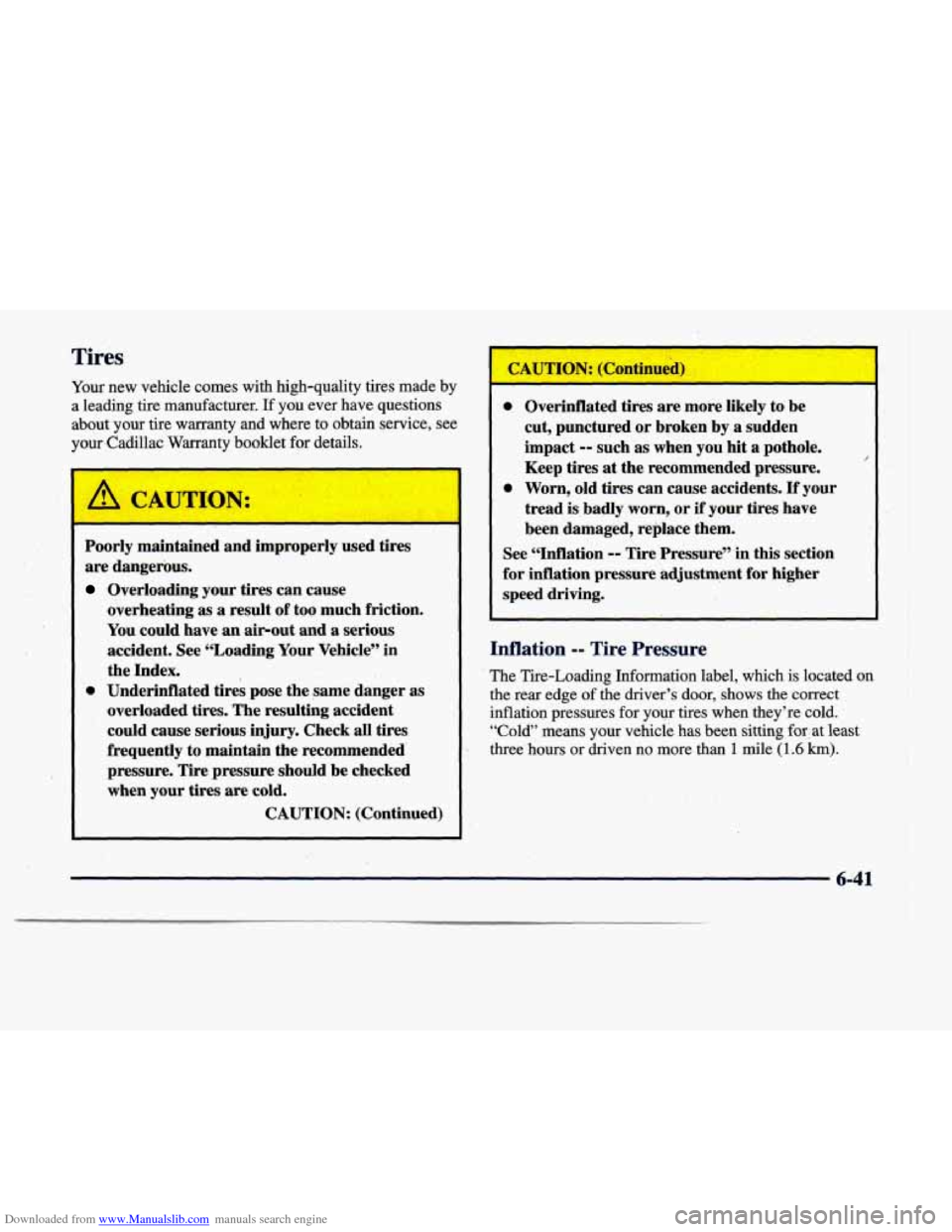
Downloaded from www.Manualslib.com manuals search engine Tires
Your ~ew vehicle comes with high-quality tires made by
a leading tire manufacturer. If you ever have questions
about your tire warranty and where ,to obtain service, see
your-Cadillac Warranty booklet for details.
I-
A CAUTION:
L
Poorly maintained and improperly used tires
are dangerous.
Overloading your tires can cause
overheating as
a result of too much friction.
You could have an air-out and a serious
accident. See “Loading Your Vehicle” in the Index.
‘0 Underinflated tires pose the same danger as
overloaded tires. The resultihg accident
could cause serious injury. Check all tires
frequently to maintain the recommended’
pressure. Tire pressure should be checked when
your tires are cold.
CAUTION: (Continued) CAUTION:
(Continued)
0 Overinflated tires are more likely to be
cut, punctured or broken by
a sudden
impact
-- such las when you hit a pothole.
Keep tires at the recommended pressure.
0 Worn, old tires can cause accidents. If your
tread is badly worn, or
if your tires have
been damaged, replace them.
See “Inflation
-- Tire Pressure’’ in this section
for .inflation pressure adjustment for higher
speed driving.
Inflation -- Tire Pressure
The Tire-Loading Information label, which is located on
the rear edge of the driver’s door, shows the correct
inflatiop pressures for your tires when they’re cold.
“Cold” means your vehicle has been sitting for, at least.
three’ hours or driven no more than
1 mile (1.6 km).
6-41
I -. ..
Page 329 of 386
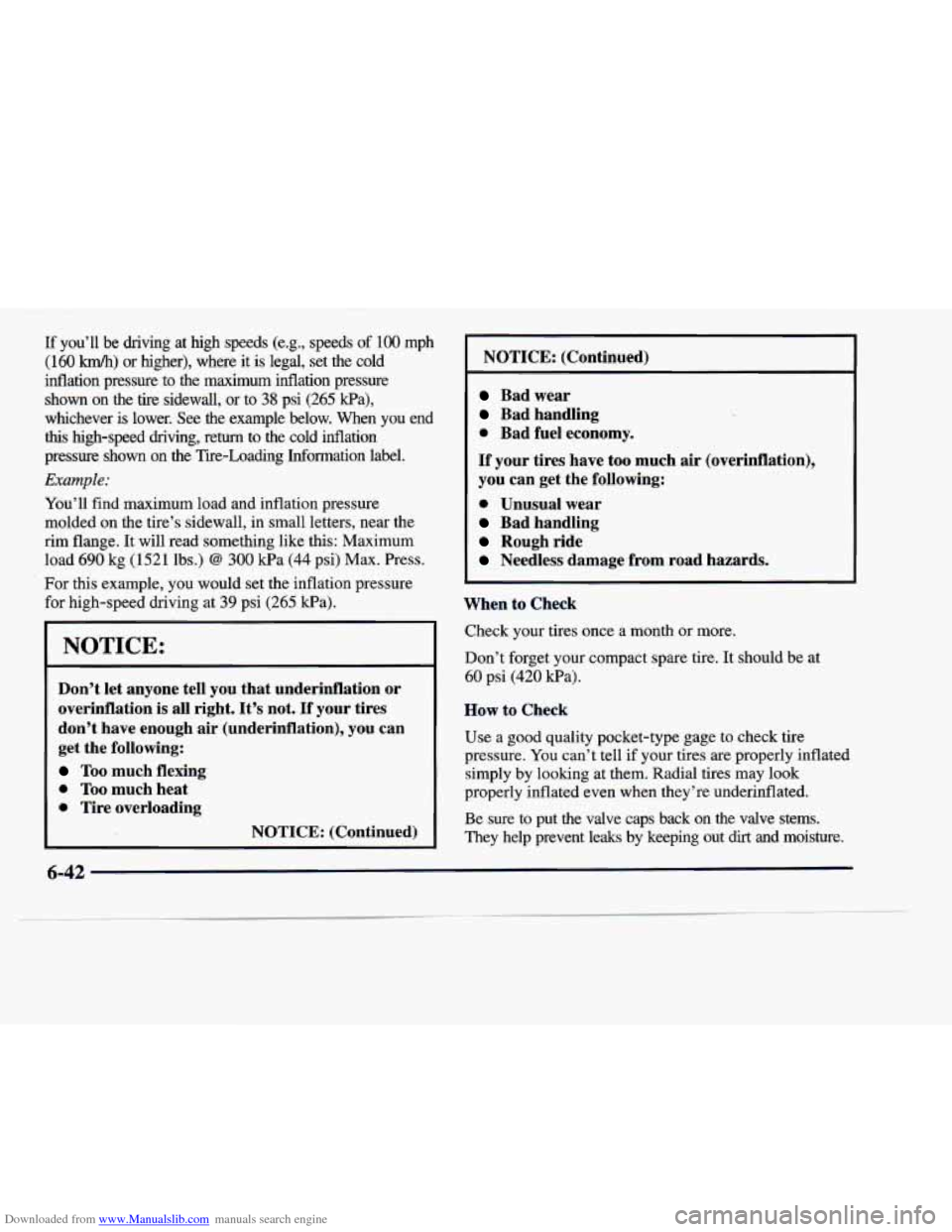
Downloaded from www.Manualslib.com manuals search engine - -
If you’ll be driving at high speeds (e.g., speeds of 100 mph
(160 km/h) or higher), where it is legal, set the cold
inflation pressure to the maximum inflation pressure shown on the
tire sidewall, or to 38 psi (265 kpa),
whichever is lower. See the example below. When you end
this high-speed driving, return to the cold inflation
pressure shown on the Tire-Loading Information label.
Example:
You’ll find maximum load and inflation pressure molded
on the tire’s sidewall, in small letters, near the
rim flange. It will read something like this: Maximum load 690
kg (1521 lbs.) @ 300 Wa (44 psi) Max. Press.
For this example,
you would set the inflation pressure
for high-speed driving at
39 psi (265 kPa).
NOTICE:
Don’t let anyone tell you that underinflation or
overinflation is all right.
It’s not. If your tires
don’t have enough air (underinflation), you can
get the following:
Too much flexing
0 Too much heat
0 Tire overloading
NOTICE: (Continued)
NOTICE: (Continued)
Bad wear
Bad handling
0 Bad fuel economy.
If your tires have too much air (overinflation),
you can get the following:
0 Unusual wear
Bad handling
Rough ride
Needless damage from road hazards.
When to Check
Check your tires once a month or more.
Don’t forget your compact spare tire. It should be at
60 psi (420 kPa).
How to Check
Use a good quality pocket-type gage to check tire
pressure.
You can’t tell if your tires are properly inflated
simply by looking at them. Radial tires may look
properly inflated even when they’re underinflated.
Be sure to put the valve caps back on the valve stems.
They help prevent leaks
by keeping out dirt and moisture.
6-42
Page 330 of 386
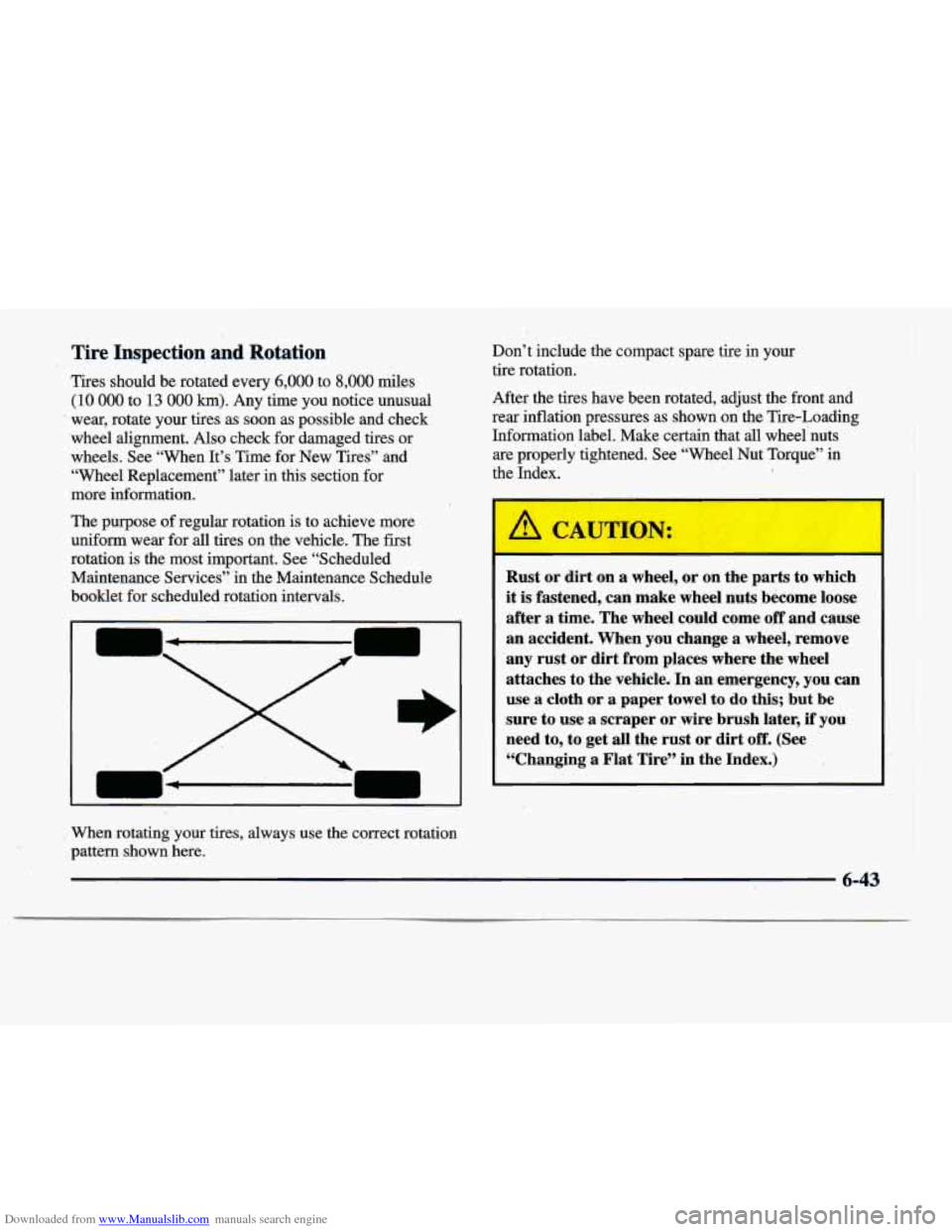
Downloaded from www.Manualslib.com manuals search engine Tire Inspection and Rotation
Tires should be rotated every 6,000 to 8,000 rriiles
(10 000 to 13 000 krn). Any time you notice unusual
. wear, rotate your tires as soon as possible and check
wheel alignment.
Also check for damaged tires or
wheels. See “When It’s Time for New Tires” and
“Wheel Replacement” later
in this section for
more information.
The purpose of regular rotation
is to achieve more
uniform wear for
all tires on the vehicle. The first
rotation
is the most important. See “Scheduled
Maintenance Services” in the Maintenance Schedule
booklet for scheduled rotation intervals.
When rotating your tires, always use the correct rotation
pattern shown here. Don’t include the compact spare tire
in your
tire rotation.
After the tires have been rotated, adjust the front and
rear inflation pressures as shown on the Tire-Loading
Information label. Make certain that
all wheel nuts
are properly tightened. See “Wheel Nut Torqoe” in
the Index.
Rust or dirt on a wheel, or on the parts to which
it is fastened, can make wheel nuts become loose
after a time. The wheel could come
off and cause
an accident. When you change
a wheel, remove
any rust
or dirt from places where the wheel
attaches to the vehicle.
In an emergency, you can
use
a cloth or a paper towel to do this; but be
sure to use a scraper or wire brush later,
if you
need to, to get all the rust or dirt
off. (See ’ .
“Changing a Flat Tire” in the Index.)
6-43